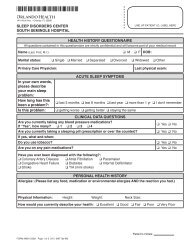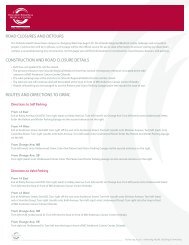Advanced Hemodynamics - Orlando Health
Advanced Hemodynamics - Orlando Health
Advanced Hemodynamics - Orlando Health
You also want an ePaper? Increase the reach of your titles
YUMPU automatically turns print PDFs into web optimized ePapers that Google loves.
<strong>Advanced</strong> Hemodynamic Monitoring<br />
Contraindications for PAC<br />
Currently there are no absolute contraindications to inserting a PAC. However, its use must be<br />
justified in that its use is imperative to diagnostic or treatment strategies. Some of the relative<br />
contraindications include the following:<br />
<br />
<br />
<br />
<br />
<br />
<br />
Patients with severe coagulopathies<br />
Patients with a prosthetic right heart valve<br />
Patients with an endocardial pacemaker<br />
Patients with severe vascular disease<br />
Patients with pulmonary hypertension<br />
Patients in a location that lacks the availability of physicians trained and skilled in insertion<br />
and flotation and the principles of blood flow, measurement of intravascular pressures, and<br />
interpretation of hemodynamic data<br />
PAC Set Up and Insertion<br />
As Replicated from the Fundamentals of <strong>Hemodynamics</strong> SLP:<br />
Hemodynamic pressure monitoring systems detect changes in pressure within the vascular system<br />
and convert those changes into digital signals. The digital signals are then displayed on a monitor as<br />
waveforms and numeric data.<br />
What will you see:<br />
There are several types of PA catheters with various features and varying numbers of lumens. It is a<br />
long hollow flexible catheter that is generally yellow in color. The PAC can have varying numbers<br />
of pigtails with corresponding lumens and tunnels. Typically you may see a PAC with four or five<br />
lumens each representing the following:<br />
Proximal injectate port- used for monitoring right atrial pressures<br />
PA distal port- used for measuring PA systolic, diastolic, and mean pressures<br />
Balloon inflation port- used to inflate the balloon for the purposes of flotation during<br />
insertion and obtaining PA occlusion pressures (also known as pulmonary capillary wedge<br />
pressure or pulmonary artery occlusion pressure [PAOP/PAWP].<br />
Thermistor wire connector- used for connecting to a cable for measuring cardiac output and<br />
blood temperature.<br />
The PA catheter will have a series of encircling black lines, which allow the clinician to estimate<br />
the location of the catheter tip in centimeters. Each thin black line will equal 10 cm, while the<br />
thicker black lines will equal 50 cm.<br />
Copyright 2010 <strong>Orlando</strong> <strong>Health</strong>, Education & Development 10

















